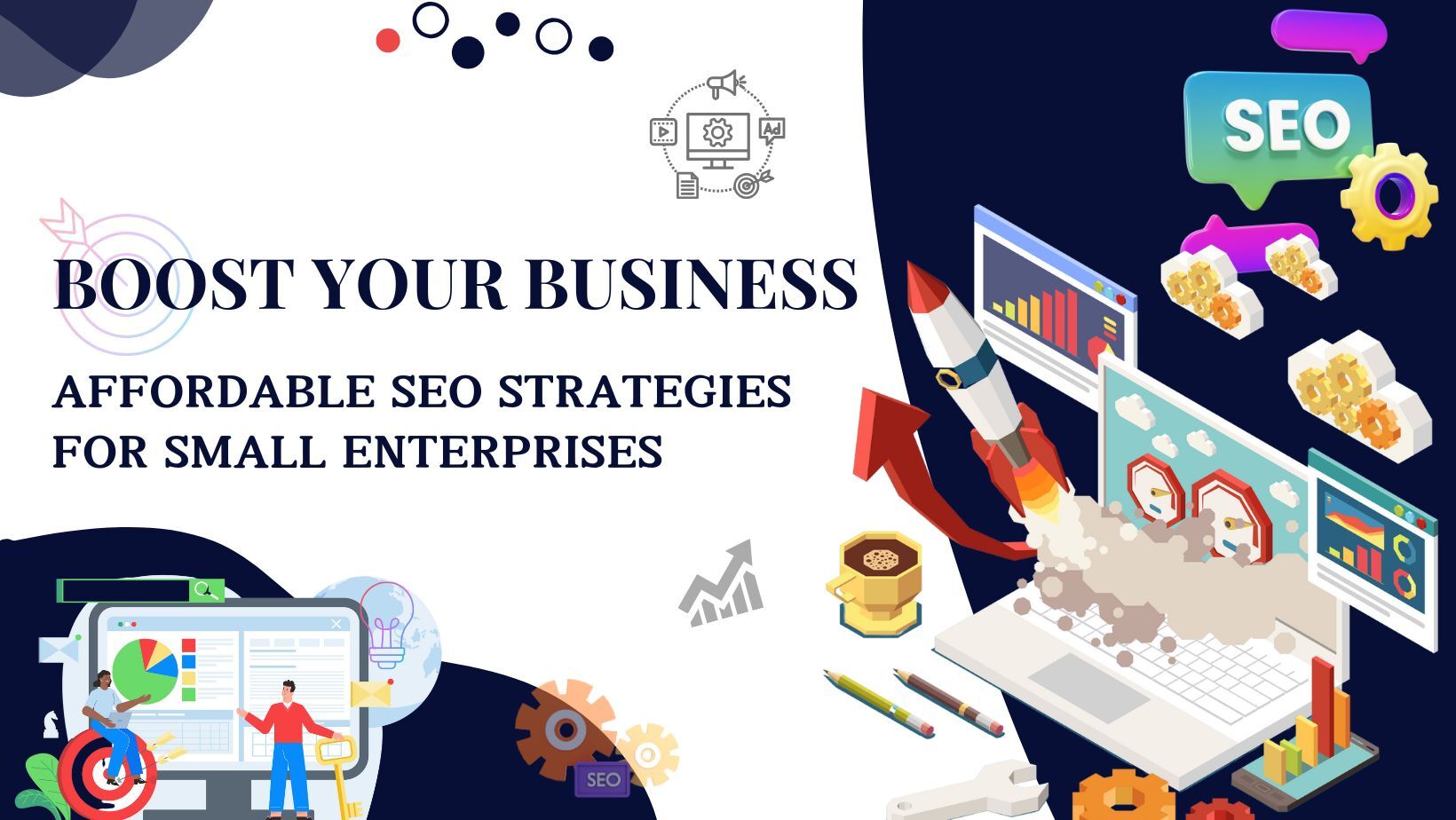Well you’re not alone.
Most small businesses struggle to get their websites noticed by search engines. But what if I told you there are many SEO strategies that can boost your online presence without costing a fortune.
Table of Contents
ToggleThis blog post will discuss the proven SEO strategies to get organic traffic on your website and climbing the search engine rankings, all without spending a fortune. But before that, you should know why you even need SEO itself?
Why Should Small Businesses Opt For Affordable SEO Strategies?
SEO is a long-term strategy designed for lasting impact. While paid ads and pay-per-click (PPC) campaigns deliver quick results, SEO focuses on building a strong, sustainable foundation for organic traffic, steadily increasing visibility over time.
What does this mean for you?
SEO is particularly advantageous for small businesses, as it allows them to achieve a higher return on investment (ROI) compared to other marketing channels. This makes it a cost-effective solution even for those who are on budget constraints. Let’s discuss the most valuable SEO strategies.
Top SEO Strategies For Small Businesses To Boost Businesses
- 1. Implementing Local SEO Practices
Small businesses often target customers from nearby places–requiring implementation of local SEO strategies. It ensures that your business appears prominently in local search results when potential customers search for services or products near them, such as “restaurants near me.”
Local SEO is more crucial for small businesses as it targets a highly relevant audience, drives traffic, and builds trust within the local community.
There are few key elements of Local SEO for small businesses which we will be discussing in the blog.
- Signing Up For GMB/ABC: The first step involves signing up for “Google My Business” and “Apple Business Connect”, followed by claiming your business listing. This will allow you to manage your online presence on maps and search engines. It allows customers to read reviews, post reviews and find directions right at their fingertips. It’s like putting your business on the map.
- Optimize Your Business Profile On Maps: Once you’ve set up your business profile on Google My Business (GMB) or Apple Business Connect, it's time to optimize your business profile. Here is how you can do it.
- a. Add accurate and consistent details, including your business name, address, phone number (NAP), and business category. Ensure the information matches your website and other online directories.
- b. Choose primary and secondary categories that best describe your business. This should be followed by writing a detailed business description—including relevant keywords and keeping it concise.
- c.Add high quality professional images that best represent your business location, products, environment and services.
There are few key elements of Local SEO for small businesses which we will be discussing in the blog.
- 2. Conduct Keyword Research
Effective keyword research involves understanding search intent, analyzing competitors, and leveraging tools like Google Keyword Planner or Ahrefs to uncover high-impact keywords.
By targeting these niche phrases, small businesses can attract qualified traffic, improve conversion rates, and carve out a competitive edge in their market.
- 3. Make Insightful Content Inclined To User Intent
Content is king—you must be bored of reading this. But the real deal is not content, it’s quality content that ranks.
But, What are the components of quality content?
- Fulfill User Intent: It should satisfy the intent behind the search query and hence relevant to the target audience. It should directly answer the question that was asked from the end user.
- Provide in-depth analysis: The content should be original—not just plagiarized or copy pasted. It should provide a comprehensive analysis of the topic with images( if needed).
- Provide Excellent User Experience: The content should have a proper heading, subheadings, and bullet points—making it easy to read and navigate, both to the crawler and user. Apart from the above, the content should have a logical flow and not be written in a haphazard manner.
- Consistency is Key: Publish fresh content regularly to keep search engines crawling your site and to show that your website is active. You should also update the old content with the latest available information to keep them relevant.
- 4. Incorporate On-Page SEO Practices
No matter how insightful content you create—if you don’t practice On-Page SEO, your webpage is not going to rank in SERP. Let’s look into the key elements of On-Page SEO.
- Title Tags: You need to craft unique and keyword rich titles for each page. You can either think of creative topics or take GenAI’s help for keyword rich titles.
- Meta Descriptions: It’s the summary of web page’s content that appears in search results. You should write concise and engaging meta descriptions for better rankings.
- Internal Linking: This is linking your keywords/ services to other relevant pages on your website to keep visitors engaged and enhance your site’s SEO. For instance, a blog post offering app development tips could link to your services page or another article about app development topics.
- Headings: By using proper header tags like H1, H2, H3,H4, you can ideally structure your content. For instance, if your heading is in H2, your subheadings should be in H3, and so on.
- Image Optimization: It is the practice of creating high-quality images in the ideal format, size, and resolution to increase user engagement. It also involves labeling images with metadata so search engine crawlers can read them and understand page context.
- 5. Have A Mobile-Friendly Website
As more and more people are accessing pages from the smartphone, Google has implemented mobile-first indexing. Having a mobile friendly website is somewhere the only way to show up at the top of search results. You can improve the user experience of your mobile website by following these steps:
- Using Responsive Design: Ensure your website adjusts to different screen resolutions and sizes with getting a lag or loading issue.
- Having A Fast Load Time: Slow websites only increase bounce rates and you don’t want that. That’s why you should optimize images, use fewer plug-ins and minimize codes to make your website feel faster.
- Easy Navigation: Making your website easier for navigation means a lot to the users. For example: if you provide multiple services, you can categorise those services under one umbrella rather than making separate links at the homepage.
You can utilize tools like Google’s PageSpeed Insights to identify areas for improvement and optimize images, enable browser caching, and leverage Content Delivery Networks (CDNs) to enhance your loading speed.
- 6. Optimize “People Also Ask” Segment
The new SERPs go beyond the traditional links. It often shows a few similar questions under the name–People also ask (PAA). This is a SERP feature that shows additional questions somewhere related to the original search query.

You should also consider optimizing for PAA as it helps you to gain more visibility by supporting you to rank for additional relevant keywords.
To get an overview of the existing SERP features for your keywords, consider using SEO Tools. When you get an idea of “people also ask” questions, you can optimize them by using those questions in your subheaders. Also, consider giving a dictionary style answer to PAA questions at the beginning of your article.
- 7. Tracking Your SEO Metrics
Monitoring your SEO performance is crucial for small businesses. It helps them to identify strengths and areas for improvement whether their SEO strategy is working effectively or not. By using tools such as Google Search Console, Google Analytics or Semrush, you can check your overall performance.
Tools like Google Search Console can help you in:
- Monitor website performance in search results.
- Identify and fix technical issues like crawl errors.
- Submit your sitemap to ensure all pages are indexed by search engines.
Similarly Google Analytics/Semrush can help you:
- Track website traffic and understand user behavior.
- Measure key metrics like bounce and conversion rates.
- Assess the effectiveness of your SEO efforts to make data-driven decisions.
- 8. Leveraging Social Media For SEO
Using social media as part of your SEO strategy can be a game-changer for small businesses, even though it doesn’t directly affect search rankings. Social media platforms help amplify your content’s reach, driving traffic to your website and increasing your overall online visibility.
They also offer opportunities to build brand authority, create audience engagement, and generate backlinks when your content gets widely shared. Here’s how social media can enhance your SEO efforts:
- Drives Traffic: Sharing your content on platforms like Facebook, IG, LinkedIn, and Reddit directs users to your website, increasing traffic and signaling its relevance to search engines.
- Generates Backlinks: Viral or highly engaging content on social media can attract backlinks from other websites, which are a key factor in SEO rankings.
- Appears in Search Results: Social media profiles often rank on the first page of search results, giving your business additional visibility and credibility.
- Enhances Local SEO: Platforms like Facebook allow you to optimize your business profile with location-based keywords, making it easier for local customers to find you.
- Encourages Audience Engagement: Direct interaction with your audience through comments, shares, and messages helps you understand user intent and create content that resonates with their needs.
- 9. Use Tools To Monitor Unlinked Brand Mentions
Media monitoring tools are a powerful resource for identifying unlinked brand mentions—instances where your business is mentioned online but not linked back to your website.
By using these tools, you can track such mentions across blogs, news articles, social media and results provided by pre-trained LLMs( LLMs trained on static data).
Once identified, you can reach out to the website owner or author, thanking them for mentioning your brand and politely requesting a backlink. This simple yet effective SEO strategy not only strengthens your backlink profile but also enhances your website’s authority, driving more traffic and improving your search engine rankings.
- 10. Implement a Link Building Strategy
Link building is an important aspect of SEO as it reflects your credibility value to search engines and helps users to land your website. What should be your link building strategy?
Here are the three basic link building strategies you can opt for:
- a.Guestposting: It is an established methodology to get backlinks. By contributing informative articles to relevant websites in your niche, you gain valuable backlinks to your own site.
- b. Influencer Marketing: By collaboration with industry experts, journalists and influencers, you can get brand recognition/ product awareness and backlinks to your website/ social channels.
- c.Community Engagement: By actively participating in relevant online forums and communities, you can build relationships with potential customers. It may naturally get you a backlink to your website as a trusted source.
- 11. LLM-Based SEO Optimization
As of August 2024, ChatGPT attracted approximately 2.63 billion monthly visits, generating 9 billion page views. This represents a significant amount of user time being redirected away from traditional search engines—citing the need for AI overviews optimization.
Search-augmented LLMs like ChatGPT+/Gemini frequently display links as references for their results. If your brand’s domain appears in these links, it indicates that the LLM recognizes and incorporates your content into its knowledge base.
Content already cited by the LLM is an excellent starting point for planning internal linking to enhance your visibility further. To get more pages referenced in a search-augmented LLM, link from the pages that are already being referenced to other relevant content on your site.
Concluding Lines
Need a helping hand?





